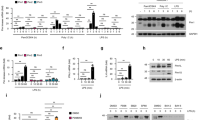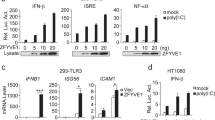Abstract
The Toll-like receptor (TLR) family has important roles in microbial recognition and dendritic cell activation1,2. TLRs 7 and 9 can recognize nucleic acids3,4,5,6 and trigger signalling cascades that activate plasmacytoid dendritic cells to produce interferon-α (IFN-α) (refs 7, 8). TLR7/9-mediated dendritic cell activation is critical for antiviral immunity but also contributes to the pathogenesis of systemic lupus erythematosus, a disease in which serum IFN-α levels are elevated owing to plasmacytoid dendritic cell activation8,9. TLR7/9-induced IFN-α induction depends on a molecular complex that contains a TLR adaptor, MyD88, and IFN regulatory factor 7 (IRF-7) (refs 10–14), but the underlying molecular mechanisms are as yet unknown. Here we show that IκB kinase-α (IKK-α) is critically involved in TLR7/9-induced IFN-α production. TLR7/9-induced IFN-α production was severely impaired in IKK-α-deficient plasmacytoid dendritic cells, whereas inflammatory cytokine induction was decreased but still occurred. Kinase-deficient IKK-α inhibited the ability of MyD88 to activate the Ifna promoter in synergy with IRF-7. Furthermore, IKK-α associated with and phosphorylated IRF-7. Our results identify a role for IKK-α in TLR7/9 signalling, and highlight IKK-α as a potential target for manipulating TLR-induced IFN-α production.
This is a preview of subscription content, access via your institution
Access options
Subscribe to this journal
Receive 51 print issues and online access
$199.00 per year
only $3.90 per issue
Buy this article
- Purchase on Springer Link
- Instant access to full article PDF
Prices may be subject to local taxes which are calculated during checkout




Similar content being viewed by others
References
Medzhitov, R. Toll-like receptors and innate immunity. Nature Rev. Immunol. 1, 135–145 (2001)
Takeda, K., Kaisho, T. & Akira, S. Toll-like receptors. Annu. Rev. Immunol. 21, 335–376 (2003)
Hemmi, H. et al. A Toll-like receptor recognizes bacterial DNA. Nature 408, 740–745 (2000)
Diebold, S. S., Kaisho, T., Hemmi, H., Akira, S. & Reis, E. S. C. Innate antiviral responses by means of TLR7-mediated recognition of single-stranded RNA. Science 303, 1529–1531 (2004)
Heil, F. et al. Species-specific recognition of single-stranded RNA via Toll-like receptor 7 and 8. Science 303, 1526–1529 (2004)
Lund, J. M. et al. Recognition of single-stranded RNA viruses by Toll-like receptor 7. Proc. Natl Acad. Sci. USA 101, 5598–5603 (2004)
Wagner, H. The immunobiology of the TLR9 subfamily. Trends Immunol. 25, 381–386 (2004)
Colonna, M., Trinchieri, G. & Liu, Y. J. Plasmacytoid dendritic cells in immunity. Nature Immunol. 5, 1219–1226 (2004)
Blanco, P., Palucka, A. K., Gill, M., Pascual, V. & Banchereau, J. Induction of dendritic cell differentiation by IFN-α in systemic lupus erythematosus. Science 294, 1540–1543 (2001)
Kawai, T. et al. Interferon-α induction through Toll-like receptors involves a direct interaction of IRF7 with MyD88 and TRAF6. Nature Immunol. 5, 1061–1068 (2004)
Honda, K. et al. Role of a transductional-transcriptional processor complex involving MyD88 and IRF-7 in Toll-like receptor signaling. Proc. Natl Acad. Sci. USA 101, 15416–15421 (2004)
Uematsu, S. et al. Interleukin-1 receptor-associated kinase-1 plays an essential role for Toll-like receptor (TLR)7- and TLR9-mediated interferon-α induction. J. Exp. Med. 201, 915–923 (2005)
Honda, K. et al. IRF-7 is the master regulator of type-I interferon-dependent immune responses. Nature 434, 772–777 (2005)
Honda, K. et al. Spatiotemporal regulation of MyD88–IRF-7 signalling for robust type-I interferon induction. Nature 434, 1035–1040 (2005)
Hayden, M. S. & Ghosh, S. Signaling to NF-κB. Genes Dev. 18, 2195–2224 (2004)
Bonizzi, G. & Karin, M. The two NF-κB activation pathways and their role in innate and adaptive immunity. Trends Immunol. 25, 280–288 (2004)
Hemmi, H. et al. The roles of two IκB kinase-related kinases in lipopolysaccharide and double stranded RNA signaling and viral infection. J. Exp. Med. 199, 1641–1650 (2004)
Perry, A. K., Chow, E. K., Goodnough, J. B., Yeh, W. C. & Cheng, G. Differential requirement for TANK-binding kinase-1 in type I interferon responses to Toll-like receptor activation and viral infection. J. Exp. Med. 199, 1651–1658 (2004)
Takeda, K. et al. Limb and skin abnormalities in mice lacking IKKα. Science 284, 313–316 (1999)
Hu, Y. et al. Abnormal morphogenesis but intact IKK activation in mice lacking the IKKα subunit of IκB kinase. Science 284, 316–320 (1999)
Li, Q. et al. IKK1-deficient mice exhibit abnormal development of skin and skeleton. Genes Dev. 13, 1322–1328 (1999)
Kaisho, T. et al. IκB kinase α is essential for mature B cell development and function. J. Exp. Med. 193, 417–426 (2001)
Senftleben, U. et al. Activation by IKKα of a second, evolutionary conserved, NF-κB signaling pathway. Science 293, 1495–1499 (2001)
Matsushima, A. et al. Essential role of nuclear factor (NF)-κB-inducing kinase and inhibitor of κB (IκB) kinase α in NF-κB activation through lymphotoxin β receptor, but not through tumor necrosis factor receptor I. J. Exp. Med. 193, 631–636 (2001)
Verthelyi, D., Ishii, K. J., Gursel, M., Takeshita, F. & Klinman, D. M. Human peripheral blood cells differentially recognize and respond to two distinct CPG motifs. J. Immunol. 166, 2372–2377 (2001)
Krug, A. et al. Identification of CpG oligonucleotide sequences with high induction of IFN-α/β in plasmacytoid dendritic cells. Eur. J. Immunol. 31, 2154–2163 (2001)
Hemmi, H., Kaisho, T., Takeda, K. & Akira, S. The roles of Toll-like receptor 9, MyD88, and DNA-dependent protein kinase catalytic subunit in the effects of two distinct CpG DNAs on dendritic cell subsets. J. Immunol. 170, 3059–3064 (2003)
Kato, H. et al. Cell type-specific involvement of RIG-I in antiviral response. Immunity 23, 19–28 (2005)
Hochrein, H. et al. Herpes simplex virus type-1 induces IFN-α production via Toll-like receptor 9-dependent and -independent pathways. Proc. Natl Acad. Sci. USA 101, 11416–11421 (2004)
Sharma, S. et al. Triggering the interferon antiviral response through an IKK-related pathway. Science 300, 1148–1151 (2003)
Acknowledgements
We thank N. Iwami, Y. Fukuda, N. Okita and E. Haga for technical assistance; Y. Hachiman and H. Fujimoto for cell sorting; and S. Haraguchi and T. Oyanagi for secretarial assistance. We also thank R. Triendl for critical review of the manuscript. This work was supported by the Advanced and Innovational Research Program in Life Sciences, the Special Coordination Fund for Promoting Science and Technology of the Ministry of Education, Culture, Sports, Science and Technology (MEXT) and Grant-in-Aid for Scientific Research of MEXT and the Japan Society for the Promotion of Science, the Uehara Memorial Foundation, the Naito Foundation, the Novartis Foundation for the Promotion of Science, and RIKEN Strategic programs. T.S. is supported by a RIKEN Junior Research Associate grant.
Author information
Authors and Affiliations
Corresponding author
Ethics declarations
Competing interests
Reprints and permissions information is available at npg.nature.com/reprintsandpermissions. The authors declare no competing financial interests.
Supplementary information
Supplementary Notes
This file contains Supplementary Methods, Supplementary Figure Legends and Supplementary Figures 1–6. (PDF 360 kb)
Rights and permissions
About this article
Cite this article
Hoshino, K., Sugiyama, T., Matsumoto, M. et al. IκB kinase-α is critical for interferon-α production induced by Toll-like receptors 7 and 9. Nature 440, 949–953 (2006). https://doi.org/10.1038/nature04641
Received:
Accepted:
Issue Date:
DOI: https://doi.org/10.1038/nature04641
This article is cited by
-
DHAV 3CD targets IRF7 and RIG-I proteins to block the type I interferon upstream signaling pathway
Veterinary Research (2023)
-
Epigenomic and transcriptomic analyses reveal differences between low-grade inflammation and severe exhaustion in LPS-challenged murine monocytes
Communications Biology (2022)
-
Regulation of the nucleic acid-sensing Toll-like receptors
Nature Reviews Immunology (2022)
-
The immune microenvironment in gastric adenocarcinoma
Nature Reviews Gastroenterology & Hepatology (2022)
-
Targeting NF-κB pathway for the therapy of diseases: mechanism and clinical study
Signal Transduction and Targeted Therapy (2020)
Comments
By submitting a comment you agree to abide by our Terms and Community Guidelines. If you find something abusive or that does not comply with our terms or guidelines please flag it as inappropriate.



